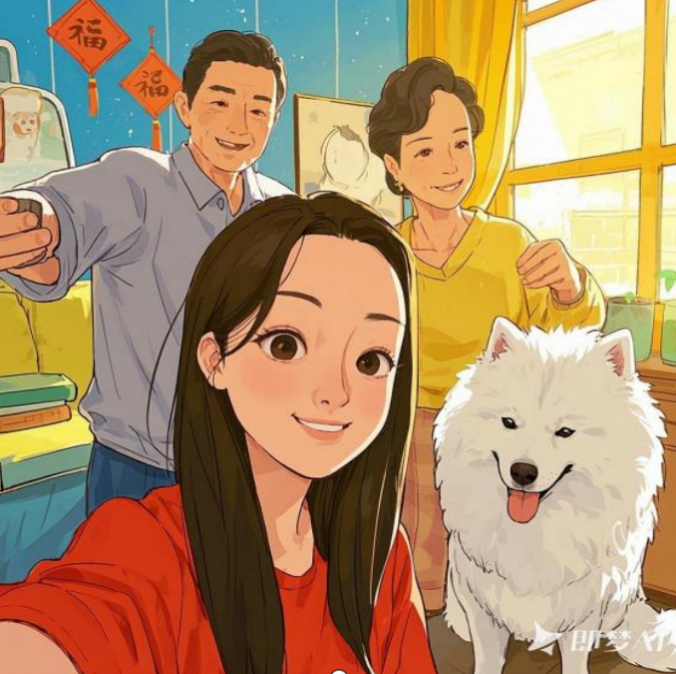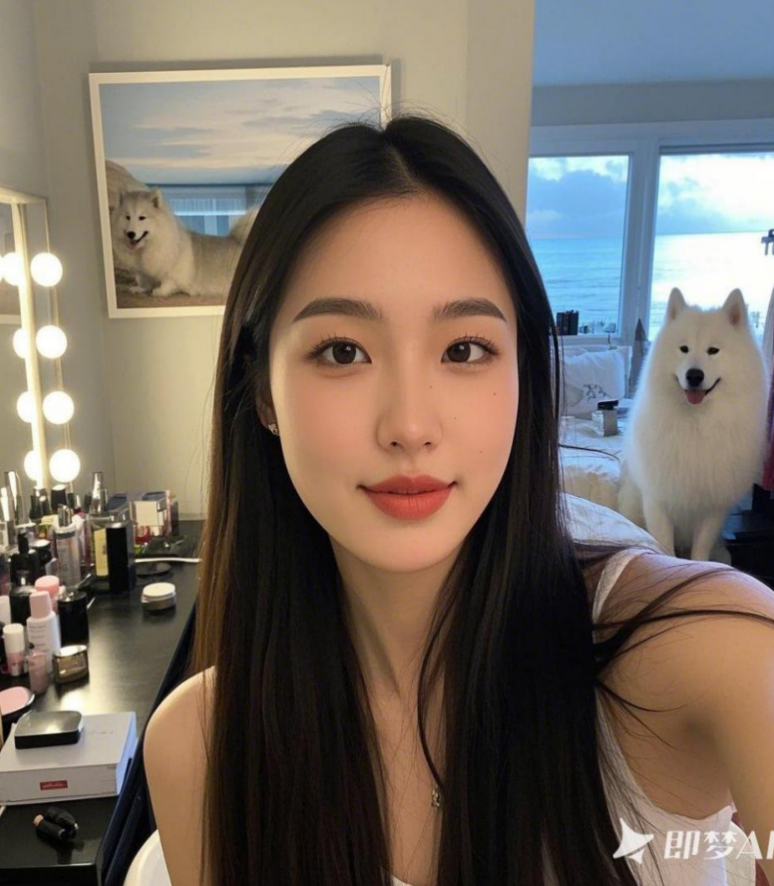I experimented with two popular AI image generators from different regions to create my digital selfies——DALL.E, which is widely used in North America, and Meng AI, a trending tool in China. To make a fair comparison, I used the exact same prompt for both:
“A 27-year-old Chinese woman; an only child living with my parents in a small city in Northeast China; I have a Samoyed dog; I enjoy shopping and dressing up.”
Even though the prompt included a decent amount of personal information, the images generated at first didn’t really capture my identity or individuality. They felt more like generalized, idealized versions of an “Asian woman” rather than me.
So, I decided to add more specific, personal touches to the prompt to guide the AI in a more authentic direction. For example:
l I wrote, “there should be a dressing table and wardrobe filled with cosmetics,” to reflect my love for makeup and fashion in daily life.
l I also added, “the background should feature a snowy day with a small vendor selling candied hawthorn,” as this scene is a classic representation of wintertime in small cities in Northeast China—and candied hawthorn is such a nostalgic local snack from my childhood.
Even after I kept tweaking and fine-tuning the prompts, I noticed something interesting — or rather, a little frustrating. The AI-generated selfies from both platforms still showed a version of me that looked younger, more flawless, and noticeably more sexualized than how I actually see myself. This isn’t just a quirky side effect of playing with filters — it points to a much deeper issue with how these algorithms work.
This photo captures my family background—I'm an only child with a Samoyed dog, and I have a happy life. Meng AI seems to have perfectly reflected my identity. However, I noticed that while my “dad” looks age-appropriate, my “mom” is portrayed as much younger than she is. Additionally, my face appears flawless—almost perfect, actually. This trend appears in several of the images I've generated.
Figure 2 is a selfie I generated using DALL.E, while Figure 3 is a selfie generated with Meng AI. Both used the same prompts, yet they produced two very different depictions of the subject.
Compared to Figure 3, Figure 2 has narrower, upward-slanted eyes, old-fashioned clothing, and a background that oozes an oriental, exotic, mysterious, and classical vibe. This is a typical Western stereotype of China. Additionally, the figure in this photo has exaggerated curves, making the image overtly sexualized (even though I never included any descriptions about body shape). This representation clearly carries an Orientalist undertone.
The woman in Figure 2 resembles the kind of controversy often sparked by ads from brands like Dolce & Gabbana and Dior, where the models they choose often present a stereotypical image of Chinese women, without reflecting the diversity of real Chinese women’s identities. (See screenshots below, Figure 4 and 5, and video: https://www.youtube.com/watch?v=594Q9CJQbD4 )
Figure 4 Screenshot of Dior's promotional photo
Figure 5 Screenshot of Dolce & Gabbana advertisement
It’s all tied to what's known as “algorithmic visibility” and “digital colonialism” — in other words, how big data tends to favor certain beauty standards (often Western and idealized). According to Yan, Viberg, Baker, and Kizilcec (2024), their experiments show that the outputs of language models (like OpenAI's GPT-4, GPT-3.5, and the various turbo versions) tend to default to the self-expression values that are common in English-speaking and Protestant countries in Europe.
Transliteracy Reflection
As Marshall McLuhan famously said, “The medium is the message” — meaning it’s not just the content that matters, but how the content is delivered. The medium itself shapes how we think and how we interact with one another (McLuhan, 2013).
A blog and an academic paper, for example, are two very different ways of communicating. Blogs are inherently more interactive — there’s a sense of connection between the blogger and the reader. That connection encourages a more casual, subjective, and engaging tone. On the other hand, academic papers are about knowledge transmission, where the tone needs to be formal, objective, and carefully structured.
When adapting my academic critical analysis into a blog post, I focused on shifting my tone, language, and structure to suit this wider, more casual audience. Instead of formal academic language, I broke down some of the jargon to make it easier to understand. Besides, I wrote in the first person to make it feel more personal and relatable. I also added screenshots of my AI-generated selfies and embedded a YouTube video to keep things visually engaging and support my key points. Plus, I kept my paragraphs shorter to improve readability and flow — because no one wants to scroll through long blocks of text online.
Reference:
DW News. (2018, November 21). Dolce & Gabbana under fire over racism accusations . YouTube. https://www.youtube.com/watch?v=594Q9CJQbD4
Kircher, M. M., & Holtermann, C. (2022, December 8). How is everyone making those A.I. selfies? The New York Times.
Liao, C. (2024). My avatar’s avatars: A visual exploration and response to AI-generated avatars. Visual Culture & Gender, 19, 11–23.
McLuhan, M., & Gordon, W. T. (2013). Understanding media : the extensions of man. Gingko Press.
Yan, T., Viberg, O., Baker, R. S., & Kizilcec, R. F. (2024). Cultural bias and cultural alignment of large language models. PNAS Nexus, 3(9), 346. https://doi.org/10.1093/pnasnexus/pgae346






Comments
Post a Comment